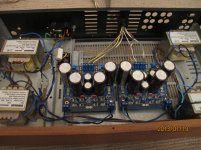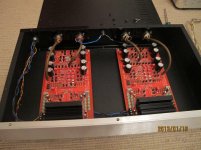My boards are powered and sat on a shelf with voltages as posted by Alfred in his replies to quan and pin 6 on one fluctuating around 0.5V and the other 1.5V.Outputs are fluctuating around 200mv.hopefully things will settle after a few days.Would it be better to case them up to aid things in settling?
these values are just fine. no need to case them for settling, its the elcaps forming (the voltage across them is fixing the little holes in the oxide, which is the cause for the leakage currents that elcaps tend to show fresh out of the bag).
My boards are powered and sat on a shelf with voltages as posted by Alfred in his replies to quan and pin 6 on one fluctuating around 0.5V and the other 1.5V.Outputs are fluctuating around 200mv.hopefully things will settle after a few days.Would it be better to case them up to aid things in settling?
One could just plug in the caps to a LM317 and live them under charge at nominal voltage while soldering the other components
This would save loads of time fiddling with the offset...
And will form caps faster
Outputs are fluctuating around 200mv.hopefully things will settle after a few days.
Have you scoped the outputs?
Hi guys, could not wait . Finally plug it in . Loading resistor 150R . Catridge mod esc stylus midas body 103, apparition tonearm N GARRARD 301. The sound is relax but detailed and tonality is very good. The main problem is hum in both chanels .
quan
quan
Have you scoped the outputs?
No scope just a couple of dmm's.
If someone wants to DIY a thing that is so complex as this one, he absolutely needs a scope. DMM is good quite for nothing, it is only an elementary tool. Don't believe those who tell you that as a DIYer you do not need a scope.
You do not need to buy an expensive instrument. It can be just a USB device like this:
USBscope50 1Gsps/75Mhz USB pen-style DSO (Digital Storage Oscilloscope), Synchrotech
But even stand alone instruments are not expensive:
Uni-Trend Group Limited
Every serious DIYer should have a scope, otherwise his results are just accidental.
You do not need to buy an expensive instrument. It can be just a USB device like this:
USBscope50 1Gsps/75Mhz USB pen-style DSO (Digital Storage Oscilloscope), Synchrotech
But even stand alone instruments are not expensive:
Uni-Trend Group Limited
Every serious DIYer should have a scope, otherwise his results are just accidental.
Updated assembly guide with the latest proposals on compensating the CCS in the power supply section if needed, and the RIAA time constants.
Thanks 🙂 great work.
Hi guys, just a question. I used 2SK170bl instead of J7. Is there any matching required for the fet?
quan
quan
The K170BLwas the original, and the j7 the substitute with a different footprint🙂. I didnt match any of the fets, and it doesnt seem to be a problem.
Hmm, added the caps as the new assembly guide. The supply lines are now deathly quiet...
Just need to run it for a couple of days to let the offset settle. Thank you all so far for your help.
Just need to run it for a couple of days to let the offset settle. Thank you all so far for your help.
Hi Alfred, after a couple of days. The voltage at pin 6 of IC still measures about +5V, and the voltage at test point of 6800uf cap is about 5V as well. Dc offset still wandering +/-200mV, the VASCL about 14.54, R5 about -0.6V and+0.5V. I tried to fired it up and running into noise issues- looking into grounding scheme. Do i need to look into the input transistors?.that looks reasonable, lets see what the opamp pin 6 voltages will be in a couple days. have you checked if your amplifiers actually amplify? I think that (apart from the LV noise) they should be working fine.... (but please verify your system is not DC coupled, or your woofers will see some interesting movements.....)
Quan
Hmm, added the caps as the new assembly guide. The supply lines are now deathly quiet...
Just need to run it for a couple of days to let the offset settle. Thank you all so far for your help.
Nice, you just made my weekend 🙂
- Home
- Source & Line
- Analogue Source
- Paradise Builders

